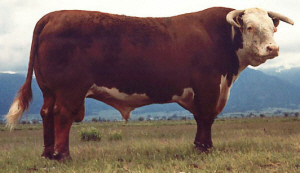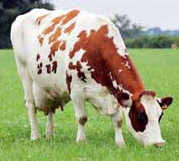



Hereford
History
The origin of the Hereford has been lost over time but it is generally agreed that it was founded on the draught ox descended from the small red cattle of Roman Briton and from a large Welsh breed once numerous along the border of England and Wales. Herefords have taken their name from the county Herefordshire, an historic agricultural region of England where this breed has evolved.The origins of this breed of cattle in the County of Herefordshire have been mentioned by various agricultural authors as long ago as the early 1600's. During the 1700's and early 1800's documented records of the breed were maintained by various individuals in and around the Herefordshire area.
These early Hereford breeders moulded their cattle with the idea in mind of a high yield of beef and efficiency of production, and so firmly fixed these characteristics that they remain today as outstanding characteristics of the breed.
 Photo courtesy of Chandler Herefords, www.chandlerherefords.com |
Other pioneering breeders were to follow the Tomkins' lead and establish the world-wide renown for the Herefordshire cattle causing their exportation from England to wherever grass grows and beef production is possible.
Herefords in the 1700's and early 1800's in England were much larger than today. Many mature Herefords of those days weighed 3,000 pounds or more. Cotmore, a winning show bull and noteworthy sire, weighed 3,900 pounds when shown in 1839. Gradually, the type and conformation changed to less extreme size and weight to get more smoothness, quality and efficiency.
Herefords were the first English cattle to be recognised as a true breed.
Characteristics
The modern Hereford is coloured dark red to red-yellow, with a white face, crest, dewlap, and underline. Herefords with white flanks and white markings below the knees and hocks are also common. Most animals have short thick horns that typically curve down at the sides of the head, but there is a polled strain in North America and UK (Polled Hereford).Mature males may weigh up to 1,800 pounds, while mature females may weigh around 1,200. They are muscular, moderate to long in length of side, adequate in length of leg, large in size, trim, and smooth. They are also well developed in the regions of valuable cuts - the back, loin, and hind quarters or round.
 Photo courtesy of Chandler Herefords, www.chandlerherefords.com |
Herefords will stand out in the arctic snows of Finland, endure the heat of Northern Transvaal, withstand the tough climate and rough grazing of northern Uruguay or the sub-tropical zones of Brazil and continue to thrive.
Herefords are generally docile and fast growing cattle with good beef quality.
Statistics
- Greater weight for age and rate of gain either at pasture or on yard feeding
- The ability to command top prices in the markets as finished beef or as store cattle
- A higher selling price for breeding stock
- Greater economy of gain in feeding
- High percentage of calf crops
- Lower wintering costs
- Docility and ease of management
- Lower labour costs
- Early maturity and longevity
Comparative
Tarentaise and Hereford Breed Effects on Cow and Calf Traits and Estimates of Individual HeterosisGenetic Components for Milk Production of Tarentaise, Hereford, and Tarentaise x Hereford Cows
Distribution
More than five million pedigree Herefords exist in over 50 countries. The export of Herefords began in 1817, spreading across the United States and Canada through Mexico to the great beef-raising countries of South America. Today, Herefords dominate the world scene from the prairies to the pampas and from the Russian steppes to the South African veldt.References (the above information was cited from the following sites)
www.herefordwebpages.co.uk
www.tsha.utexas.edu
www.chandlerherefords.com


